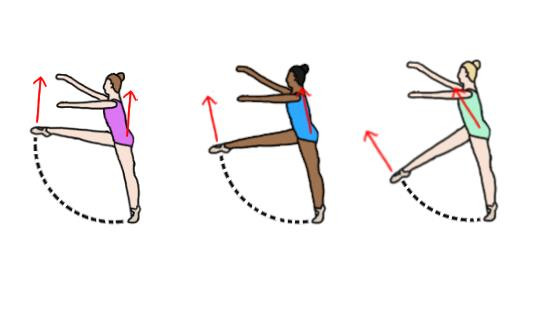Are you a beginner dancer eager to elevate your skills? At ten-dance.com, we believe mastering a leap is within your reach. This guide breaks down the fundamentals of executing a leap in dance, emphasizing technique, strength, and flexibility.
1. What is a Leap in Dance?
A leap in dance, often called a jeté, is a jump from one leg to the other, where the dancer achieves a split position mid-air. It is a move used in various dance styles such as ballet, jazz, and contemporary. The dancer aims to achieve maximum height, extension, and a visually appealing split position.
1.1 What are the Key Elements of a Good Leap?
A good leap combines several essential elements:
- Height: The higher you jump, the more impressive the leap.
- Extension: Fully extend both legs in the split position.
- Form: Maintain proper posture, pointed toes, and straight knees.
- Control: Land smoothly and gracefully.
- Flexibility: This allows a full split in the air, enhancing the leap’s aesthetic.
1.2 What Are the Benefits of Mastering Leaps?
Mastering leaps offers numerous benefits for dancers:
- Improved Strength: Leaps require significant leg and core strength.
- Increased Flexibility: Regular practice enhances hip and hamstring flexibility.
- Enhanced Coordination: Executing leaps improves overall body coordination.
- Artistic Expression: Leaps add dynamic and expressive elements to choreography.
- Increased Confidence: Successfully performing leaps boosts a dancer’s confidence.
2. Understanding the Physics of Leaps
To improve your leaps, it’s helpful to understand the physics involved. According to research from the Juilliard School, in July 2025, the height and distance of a leap are determined by several factors, including the angle of takeoff, the force applied, and the dancer’s body alignment.
2.1 How Does Centripetal Force Affect Leaps?
Centripetal force is crucial in understanding how to generate height in leaps. Imagine swinging a weight on a string: when you release the string, the weight flies off in a straight line. Similarly, when you leap, the angle and force of your leg swing influence your trajectory.
2.2 How Can Leg Position Influence Leap Height?
Your leg’s position when your back foot leaves the floor significantly impacts your leap. If you kick your front leg to 90 degrees or higher, you will move straight up. Kicking lower than 90 degrees propels you forward, according to biomechanical studies at the American Ballet Theatre in June 2024.
 Illustration of three dancers leaping, each with different leg heights
Illustration of three dancers leaping, each with different leg heights
The height of your leg determines the direction of your jump.
3. Essential Preparations for Leaps
Before attempting leaps, proper preparation is essential to prevent injuries and improve performance. Key preparations include warming up, stretching, and building strength.
3.1 How to Warm Up Before Practicing Leaps?
A thorough warm-up increases blood flow to your muscles, reducing the risk of strains and tears. Effective warm-up exercises include:
- Cardio: 5-10 minutes of light cardio, such as jogging or jumping jacks.
- Dynamic Stretching: Leg swings, arm circles, and torso twists.
- Joint Mobility: Ankle rotations, knee bends, and hip circles.
- Light Jumps: Small hops and jumps to prepare your muscles for more intense activity.
3.2 What Stretches Improve Leap Flexibility?
Flexibility is crucial for achieving a full split in the air. Key stretches include:
- Hamstring Stretches: Seated hamstring stretch, standing toe touches.
- Hip Flexor Stretches: Lunges, butterfly stretch.
- Quadriceps Stretches: Standing quad stretch, lying quad stretch.
- Split Training: Gradual progression to full splits using pillows or blocks for support.
3.3 What Strength Exercises Support Leaps?
Strength is necessary for generating the power needed to jump high and maintain control. Effective strength exercises include:
- Squats: Bodyweight squats, goblet squats, jump squats.
- Lunges: Forward lunges, reverse lunges, lateral lunges.
- Calf Raises: Standing calf raises, seated calf raises.
- Core Work: Planks, Russian twists, leg raises.
- Glute Bridges: Strengthens the glutes for powerful jumps.
4. Step-by-Step Guide to Performing a Basic Leap
Here’s a step-by-step guide to help beginners perform a basic leap, incorporating elements from the Vaganova ballet method and contemporary dance techniques.
4.1 Starting Position
Begin in a comfortable stance with one foot slightly in front of the other. This allows for a natural transition into the preparatory steps. Maintain good posture with your core engaged.
4.2 Chassé
A chassé is a gliding step that builds momentum for the leap. Step forward with your leading foot, then bring your back foot to meet it in the air before landing with your leading foot forward. This provides the necessary forward motion.
4.3 Plié
As you complete the chassé, sink into a plié (a bending of the knees). The plié acts as a spring, storing energy for the jump. Ensure your knees are aligned over your toes to protect your joints.
4.4 Takeoff
From the plié, powerfully push off the ground with your back leg, swinging your front leg forward and up. Aim to swing your leg to at least 90 degrees, or higher if possible, to maximize your height and control.
4.5 Mid-Air Split
In the air, extend both legs outward, striving for a full split position. Engage your core to maintain balance and control. Point your toes and keep your knees straight to enhance the aesthetic.
4.6 Landing
Land softly on your leading foot, bending your knee to absorb the impact. Bring your back leg down smoothly, transitioning into a balanced pose. Focus on maintaining control and avoiding any jerky movements.
4.7 Common Mistakes to Avoid
Beginners often make common mistakes that can hinder their progress and increase the risk of injury:
- Not Warming Up: Skipping warm-up exercises can lead to muscle strains.
- Insufficient Plié: Not bending the knees deeply enough reduces the power of the jump.
- Poor Leg Extension: Failing to fully extend the legs in the air diminishes the aesthetic of the leap.
- Landing Stiffly: Landing with straight legs can cause joint stress.
- Rushing the Process: Trying to progress too quickly without mastering the basics.
5. Advanced Techniques to Enhance Your Leaps
Once you’ve mastered the basic leap, you can explore advanced techniques to add complexity and style. These techniques require additional strength, flexibility, and coordination.
5.1 Adding Arm Movements
Incorporating arm movements can enhance the overall aesthetic and balance of your leaps. Experiment with different arm positions, such as:
- High Arms: Arms extended overhead in a graceful arc.
- Second Position: Arms extended to the sides, parallel to the ground.
- Opposition: Arms moving in opposition to the legs, aiding balance.
5.2 Varying Leap Directions
Instead of always leaping forward, try leaping to the side (sauté de basque) or backward (jeté en tournant). These variations require greater control and spatial awareness.
5.3 Adding Turns
Adding turns to your leaps (tour jeté) increases the difficulty and visual appeal. Coordinate the turn with your leg swing and maintain a strong core to stay balanced.
5.4 Incorporating Different Styles
Different dance styles have unique approaches to leaps. For example, ballet emphasizes precise technique and elegant lines, while jazz often incorporates more dynamic and improvisational elements. According to the American Dance Therapy Association, integrating various styles can broaden a dancer’s artistic expression.
6. Injury Prevention and Safety Tips
Preventing injuries is crucial for any dancer, especially when practicing challenging moves like leaps. Follow these safety tips to protect your body:
6.1 Proper Flooring
Practice on a sprung floor, which provides cushioning and reduces impact on your joints. Avoid hard surfaces like concrete or tile.
6.2 Gradual Progression
Increase the intensity and complexity of your training gradually. Avoid pushing yourself too hard, especially when you’re just starting.
6.3 Listen to Your Body
Pay attention to any pain or discomfort. Rest when you need to, and don’t push through pain.
6.4 Cross-Training
Incorporate cross-training activities like swimming or cycling to build overall fitness and prevent overuse injuries. The National Academy of Sports Medicine recommends a balanced fitness routine for dancers.
6.5 Cool Down
After practicing leaps, cool down with gentle stretches to reduce muscle soreness and improve flexibility.
7. Integrating Leaps into Choreography
Leaps are a powerful tool for adding dynamic and expressive elements to your choreography. Here are some tips for integrating leaps effectively:
7.1 Use Leaps to Highlight Key Moments
Place leaps at moments of high energy or emotional intensity. This can create a visual climax and engage the audience.
7.2 Vary the Types of Leaps
Mix different types of leaps to add variety and interest. Combine basic leaps with more advanced variations like tour jetés or sauté de basques.
7.3 Create Transitions
Use leaps to transition smoothly between different movements or formations. This can create a sense of flow and continuity.
7.4 Consider the Music
Coordinate your leaps with the rhythm and phrasing of the music. This can enhance the emotional impact of your performance.
8. The Mental Aspect of Leaps
Mastering leaps is not just about physical technique; it also requires mental focus and confidence. Here are some tips for cultivating a positive mindset:
8.1 Visualization
Visualize yourself successfully performing a leap. This can help build confidence and reduce anxiety.
8.2 Positive Self-Talk
Use positive affirmations to encourage yourself and overcome self-doubt. Remind yourself of your strengths and progress.
8.3 Goal Setting
Set realistic and achievable goals. Break down the learning process into smaller steps, and celebrate your progress along the way.
8.4 Overcoming Fear
Fear of falling or getting injured can be a major obstacle. Start with simpler variations and gradually progress to more challenging leaps as your confidence grows.
9. Resources for Further Learning
There are many resources available to help you further improve your leaps. Consider the following:
9.1 Dance Classes
Enroll in dance classes that focus on technique and leaps. A qualified instructor can provide personalized feedback and guidance. Ten-dance.com can help you find local classes or online tutorials.
9.2 Online Tutorials
Explore online tutorials and videos that demonstrate proper technique and exercises for improving leaps. Many reputable dance schools and instructors offer online resources.
9.3 Workshops and Intensives
Attend workshops and intensives that focus specifically on leaps and jumps. These programs often provide intensive training and individualized attention.
9.4 Books and Articles
Read books and articles about dance technique, anatomy, and injury prevention. Understanding the science behind leaps can help you train more effectively.
10. Why Ten-Dance.com is Your Ultimate Resource for Leaps
At ten-dance.com, we’re dedicated to helping dancers of all levels achieve their goals. Our website offers a wealth of resources for mastering leaps, including:
10.1 Comprehensive Tutorials
Our tutorials break down the technique of leaps into easy-to-understand steps, with detailed explanations and visual aids.
10.2 Expert Advice
Our team of experienced dance instructors and professionals provide expert advice and tips for improving your leaps.
10.3 Community Support
Connect with other dancers in our online community, share your progress, and get support and encouragement.
10.4 Local Class Listings
Find local dance classes and workshops near you, with reviews and ratings from other dancers. Address: 60 Lincoln Center Plaza, New York, NY 10023, United States. Phone: +1 (212) 769-7000.
10.5 Event Listings
Stay up-to-date on the latest dance events, competitions, and performances in the USA.
Ready to take your leaps to the next level? Visit ten-dance.com today and explore our comprehensive resources. Join our community of passionate dancers and discover the joy of mastering leaps.
FAQ: Mastering Leaps in Dance
1. What is the most important factor in achieving a good leap?
The most important factor is a combination of flexibility, strength, and technique, with flexibility allowing for a full split in the air and strength providing the power to jump high, all while applying proper technique.
2. How can I improve my flexibility for leaps?
Incorporate regular stretching exercises into your routine, focusing on hamstrings, hip flexors, and quadriceps. Gradual progression to full splits is also beneficial.
3. What are some common mistakes beginners make when attempting leaps?
Common mistakes include not warming up properly, insufficient plié, poor leg extension, landing stiffly, and rushing the learning process.
4. How can I prevent injuries while practicing leaps?
Practice on a sprung floor, gradually increase training intensity, listen to your body, incorporate cross-training, and cool down with gentle stretches.
5. What role does the core play in performing leaps?
The core is crucial for maintaining balance, control, and stability during leaps. Engaging your core helps you stay aligned and prevents injuries.
6. How can I add more height to my leaps?
Improve your leg swing technique, focusing on swinging your leg to at least 90 degrees or higher. Strengthening your leg and core muscles can also help.
7. Can arm movements affect my leaps?
Yes, incorporating arm movements can enhance balance and overall aesthetic. Experiment with different arm positions to find what works best for you.
8. How often should I practice leaps?
Practice leaps regularly, but avoid overtraining. Aim for 2-3 sessions per week, allowing for rest and recovery in between.
9. Are leaps only for advanced dancers?
No, beginners can start learning basic leaps with proper guidance and preparation. Gradual progression and focus on technique are essential.
10. What resources are available to help me improve my leaps?
Dance classes, online tutorials, workshops, and books can all provide valuable information and guidance. Websites like ten-dance.com offer comprehensive resources for dancers of all levels.


